In July, we announced a new partnership between the Culture & Heritage team at the Wikimedia Foundation and the Flickr Foundation, a non-profit dedicated to the preservation of Flickr’s vast collection of photos. Our goal was to make it easier to illustrate Wikipedia with high-quality, relevant photography from Flickr. We demoed a new tool, called Flickypedia, at GLAM Wiki 2023 in Uruguay, and now that we’ve incorporated some useful feedback from the Wikimedia community, it is ready for launch.
Flickypedia is now available, and we’re excited to share it with the broader Wikimedia community and public. Our goal was to create higher quality image records on Wikimedia Commons, with better connected data and descriptive information, and to make it easier for Flickr photographers to see how their photos are being used.
This project has achieved our original goals – and a couple of new ones we discovered along the way.
So, what is Flickypedia?
An easy way to copy photos from Flickr to Wikimedia Commons
The original vision of Flickypedia was a new tool for copying photos from Flickr to Wikimedia Commons, a re-envisioning of Magnus Manske’s popular Flickr2Commons tool, which copied around 5.4M photos. We tested the idea with Magnus and then asked for feedback from the wider Wikimedia community, starting with a presentation to the Commons Photographers User Group and a survey of reusers of Flickr photographs. We are grateful for their insights and feedback that helped to shape this tool.
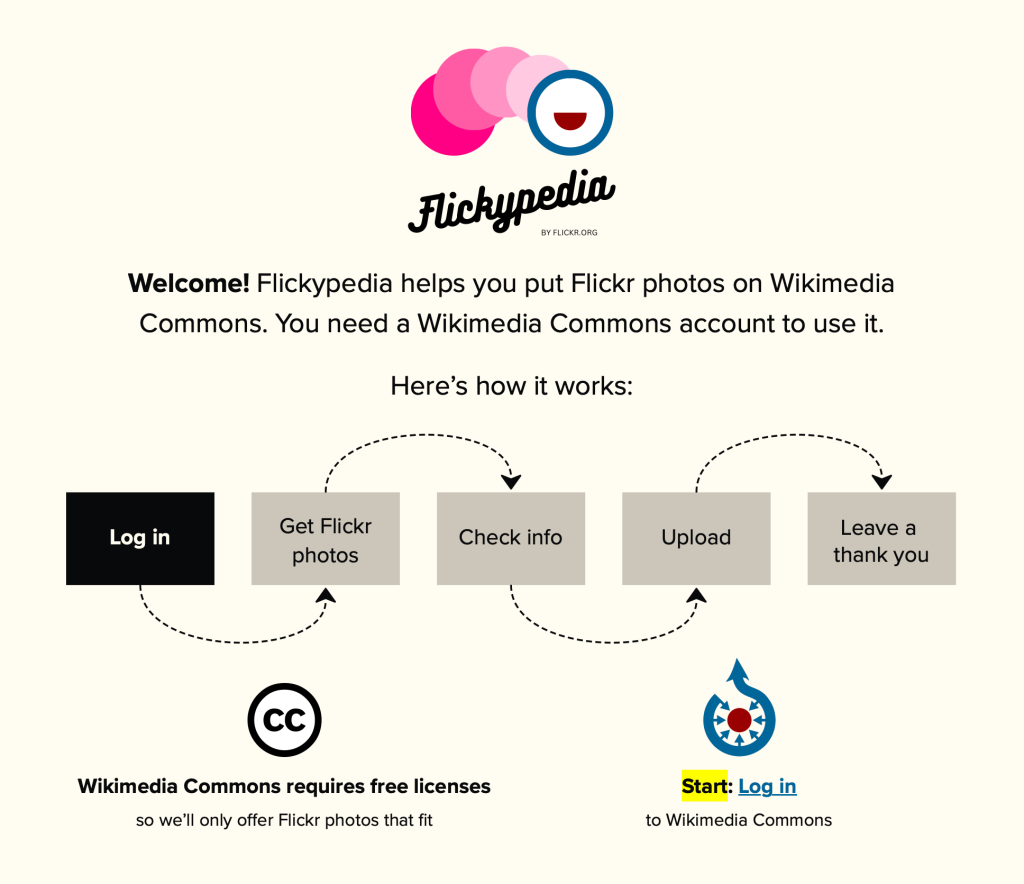
We leveraged earlier work on Flinumeratr (a web toy that creates stable Flickr URLs for individual photos, albums, galleries, and a member’s photostream), to create a simple upload tool. You start by entering a Flickr URL:
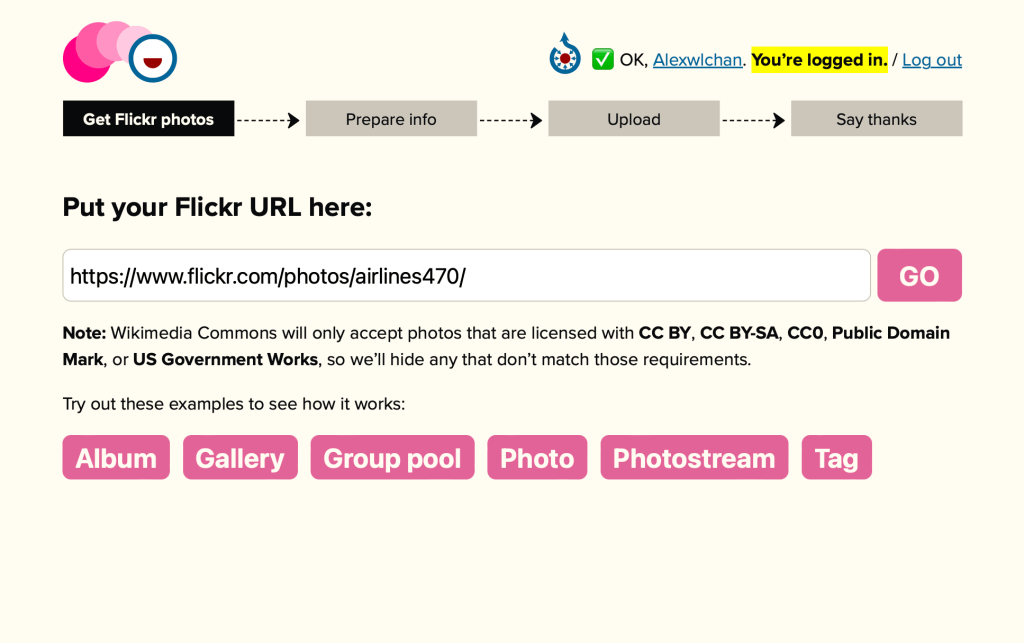
Then, Flickypedia will find all photos at that URL, and show you the ones that are suitable for copying to Wikimedia Commons. You can choose which photos you want to upload:
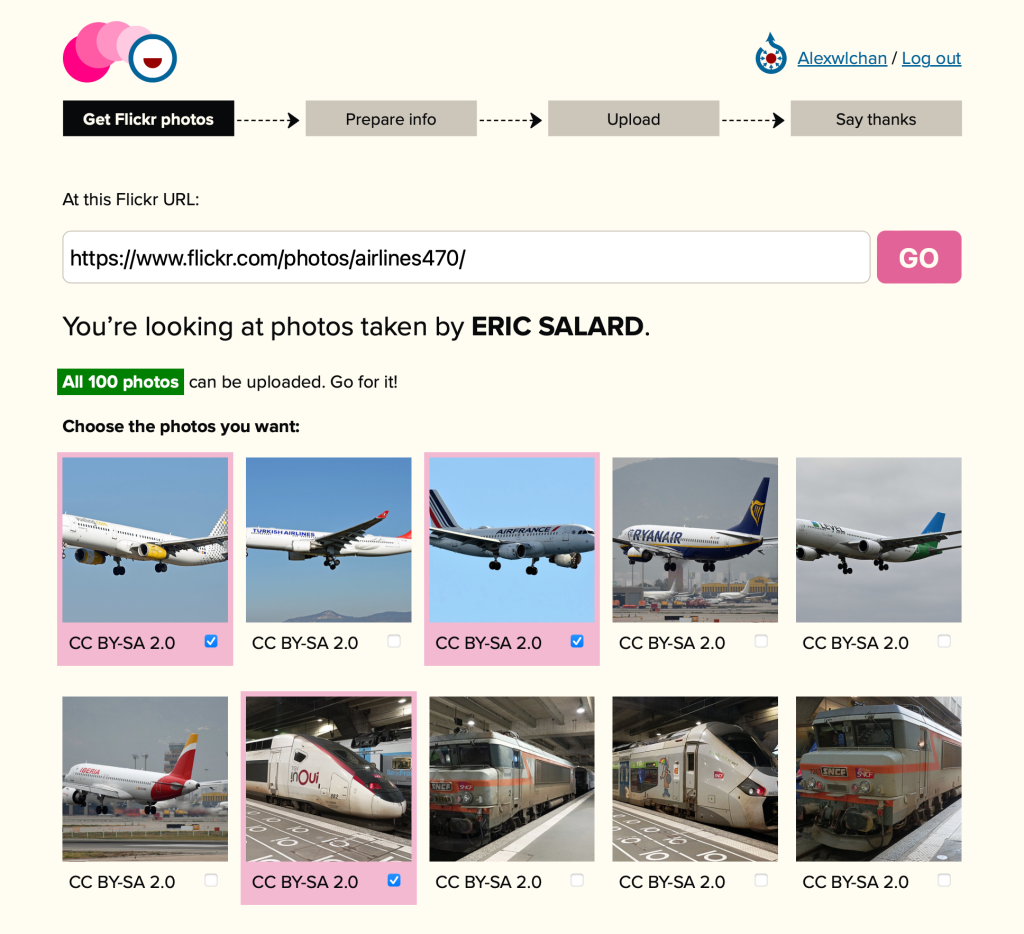
Next, you enter a title, a short description, and any categories you want to add to the photo(s):
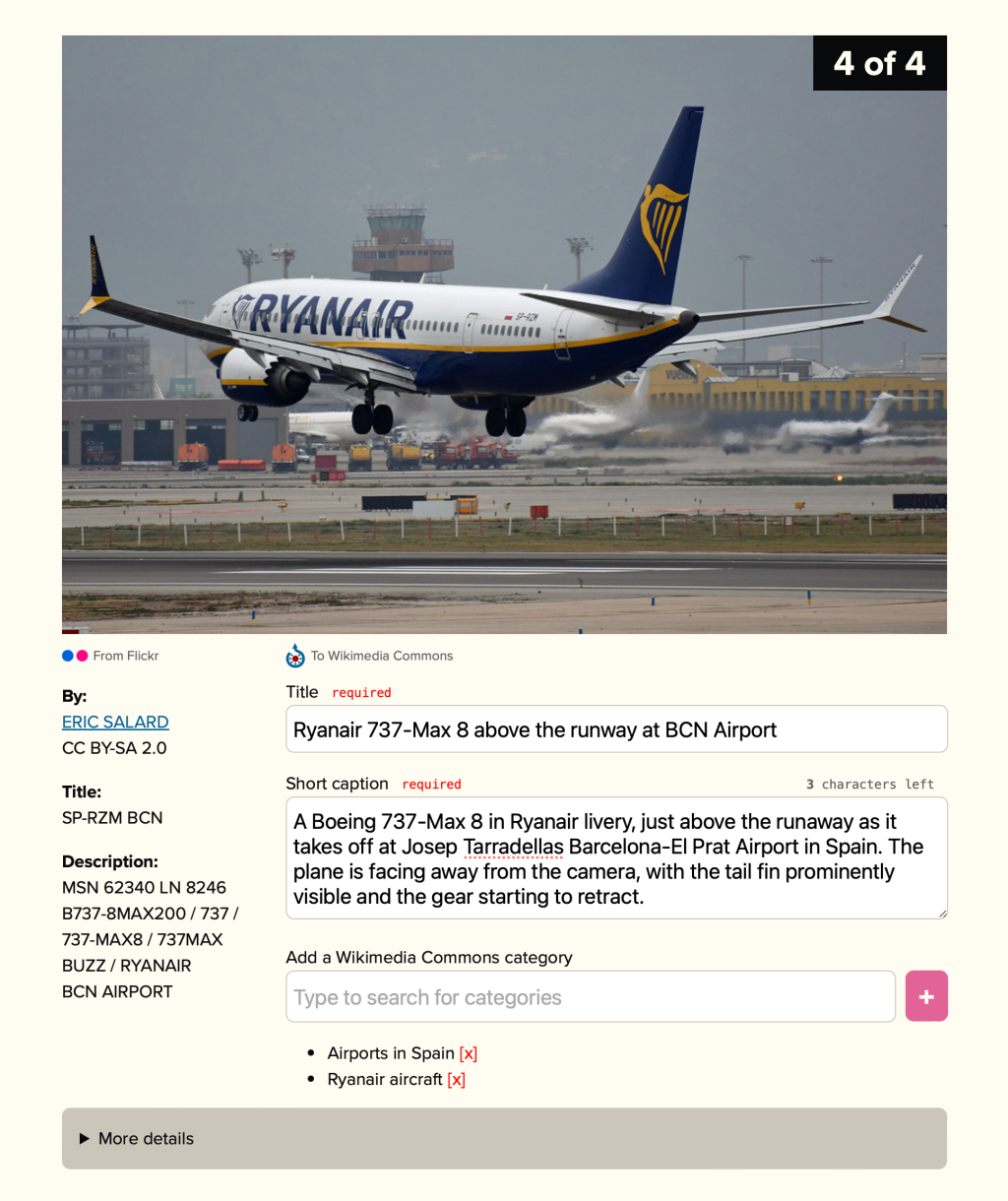
Then, you click “Upload”, and the photo(s) are copied to Wikimedia Commons. Once it’s done, you can leave a thank you on the original Flickr photo, so the photographer can see the photo in its new home:
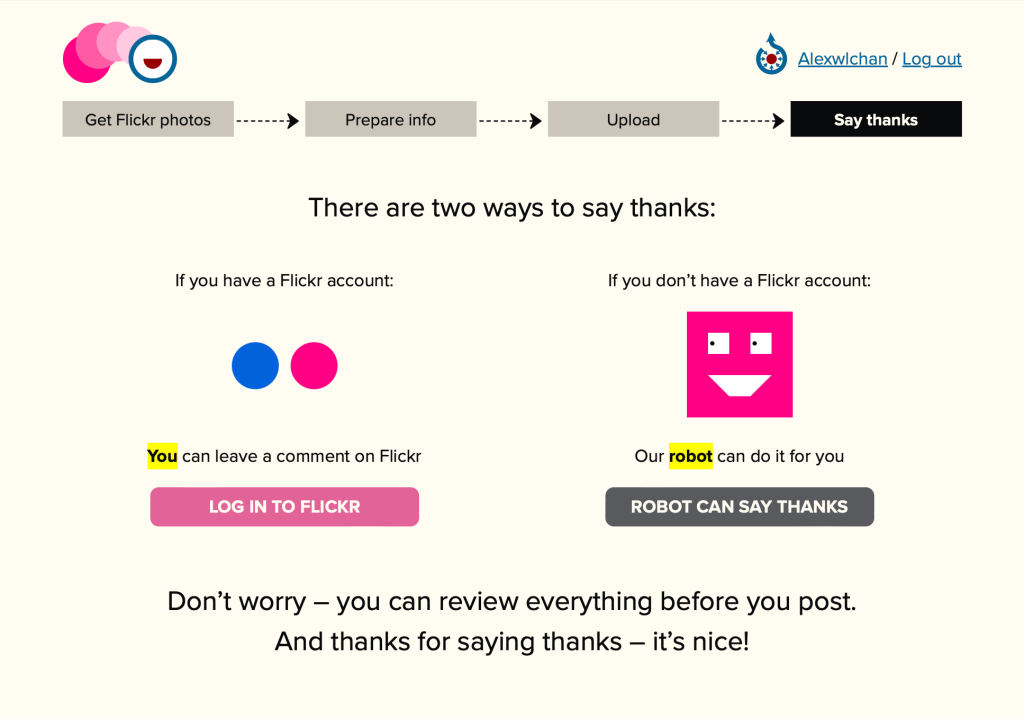
As well as the title and caption written by the uploader, we automatically populate a series of machine-readable metadata fields (“Structured Data on Commons” or “SDC”) based on the Flickr information – the original photographer, date taken, a link to the original, and so on. You can see the exact list of fields on our data modeling page, which was developed with feedback from the Wikimedia community, especially Jmabel, Andy Mabbett (Pigsonthewing), MB-one, Samwilson, Spinster, Multichill, XRay, Dominic, and JJ Dearborn. This should make it easier for Commons users to find the photos they need, and it maintains the link to the original photo on Flickr.
This flow has a little more friction than some other Flickr uploading tools, which is by design. We want to encourage high-quality descriptions and metadata for carefully selected photos, rather than just bulk copying for the sake of copying. Our goal is to get high-quality photos on Wikimedia Commons, with rich metadata which enables them to be discovered and used on Wikipedia – so that’s what the Flickypedia tool is designed to support.
Reducing risk and responsible licensing
Flickr photographers can choose from a variety of licenses, and only some of them can be used on Wikimedia Commons: CC0, Public Domain, CC BY and CC BY-SA. If it’s any other license, the photo shouldn’t be on Wikimedia Commons, according to its licensing policy. We engaged the GLAM-E Lab to develop a framework for responsible licensing, based on a careful review of the community’s past discussions about ‘Flickr washing’ and the uncertain status of the ‘no known copyright restrictions’ label used on Flickr Commons.
As we were building the Flickypedia uploader, we took the opportunity to emphasize the need for responsible licensing. When you select your photographs, it checks the licenses, and doesn’t allow you to copy anything that doesn’t have a Commons-compatible license:
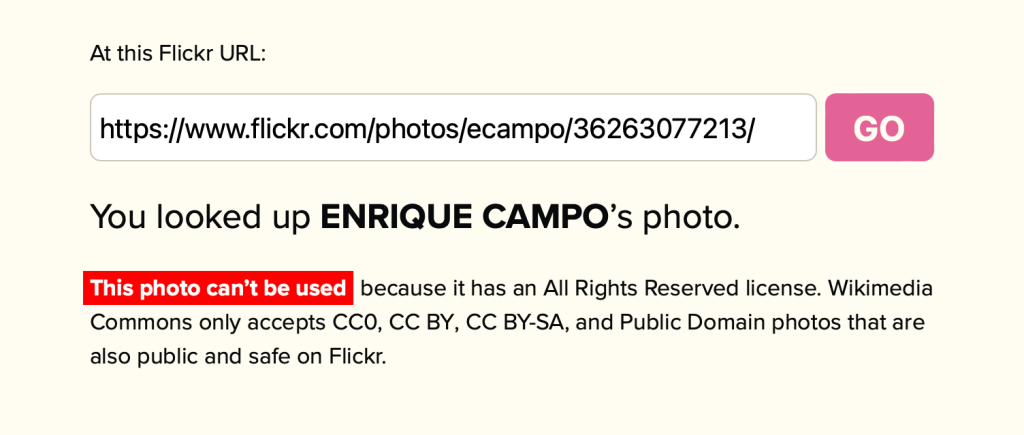
Bot: Making Flickr metadata better for all Flickr photos on Commons
That’s great for new photos uploaded with Flickypedia – but what about photos uploaded with other tools, tools that don’t use this field? What about the 11M+ Flickr photos already on Wikimedia Commons? How do we find them?
To fix this problem, the Flickr Foundation created a new Wikimedia Commons bot: Flickypedia Backfillr Bot. It goes back and fills in structured data on Flickr photos on Commons, including the Flickr Photo ID property. It uses our URL parser to identify all the different forms of Flickr URL.
This bot is still in a preliminary stage—waiting for approval from the Wikimedia Commons community—but once granted, it will be able to improve the metadata for every Flickr photo on Wikimedia Commons. In addition, it can create a hook that other tools can use – either to fill in more metadata, or search for Flickr photos.

Flickypedia started as a tool for copying photos from Flickr to Wikimedia Commons. From the very start, we had ideas about creating stronger links between the two – for example, the “say thanks” feature, where uploaders could leave a comment for the original Flickr photographer – but that was only for new photos.
Along the way, we realized we could build a proper two-way bridge, and strengthen the connection between all Flickr photos on Wikimedia Commons, not just those uploaded with Flickypedia.
We think this ability to follow a photo around the web is really important – to see where it’s come from, and to see where it’s going. A Flickr photo isn’t just an image, it comes with a social context and history, and being uploaded to Wikimedia Commons and used to illustrate Wikipedia is the next step in its journey. You can’t separate an image from its context.
This work fits within a broader Content Mobility program at the Flickr Foundation. As we start to focus on the idea of a Data Lifeboat, we’ll spend even more time looking at how to preserve the history of a photo – and Flickypedia has given us plenty to think about.
If you want to use Flickypedia to upload some photos to Wikimedia Commons, visit www.flickr.org/tools/flickypedia.
If you want to look at the source code, go to github.com/Flickr-Foundation/flickypedia.

Can you help us translate this article?
In order for this article to reach as many people as possible we would like your help. Can you translate this article to get the message out?
Start translation